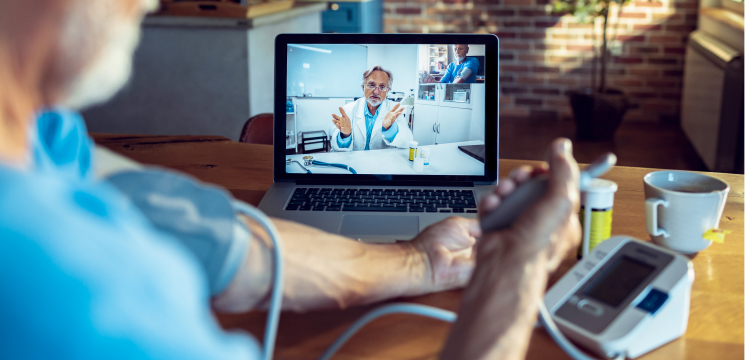At one time, getting sick required calling and making an appointment at your family doctor’s office, waiting until your appointment time, and then driving to the doctor's office. Upon arrival you had to drag your sick self into the office, where you would be stuck sitting in a waiting room, until a nurse called back to an exam room. Once in the exam room, you might wait some more until the doctor finally appeared to examine you. After all this trouble, you would finally be able to get a prescription and go home to rest.
Thankfully, due to modern advances in technology and the accessibility of healthcare in general, this isn't the only option the next time you begin feeling sick. In recent years, most medical practices have begun offering telehealth services, in addition to traditional appointments. While this technology may not be appropriate for every situation. There are many times when it could be an effective means of being seen without having to make the trek to your doctor’s office.
So, what is telehealth exactly? Basically, telehealth is a secure video call (or other form of online/virtual communication) that is specifically designed for medical use. It is typically part of an electronic medical record system that you can access online. It enables medical practitioners to schedule a "visit" with you from the comfort of your own home. Read on to learn more about telehealth, its benefits, and how it can help you get the medical care you need.

Telehealth is a form of healthcare delivery that uses technology to provide remote medical services. It allows patients to receive medical care from a distance, without having to physically visit a doctor's office or hospital. Telehealth includes video conferencing, phone calls, emails, and other forms of communication between patients and healthcare providers. This type of healthcare delivery is becoming increasingly popular, as it allows patients the convenience of visiting a doctor without ever leaving their house.
What Can Telehealth Be Used For?
Telehealth can be used for a variety of medical services, including diagnosis and treatment of illnesses, mental health counseling, physical therapy, and more. It also allows for remote monitoring of chronic conditions such as diabetes or heart disease. Telehealth can be especially beneficial for those who live in rural areas, as it eliminates the need to travel long distances for medical care.
Telehealth offers a number of benefits for both patients and healthcare providers. Consider them below:
Telehealth offers flexibility for both patients and healthcare providers. Patients can access medical care from the comfort of their own home, without having to take time off work or arrange transportation/childcare. Healthcare providers can also offer services to a wider range of patients, as they don't have to be physically present in the same location.
Telehealth can help reduce costs for both patients and healthcare providers. Patients can save money on transportation costs and time off work, while healthcare providers can reduce overhead costs associated with running a physical office.
Telehealth can help improve access to care for those who live in rural or underserved areas. It also allows patients to receive medical care more quickly, as they don't have to wait for days on an appointment or travel to a doctor's office.
Telehealth can help improve the quality-of-care patients receive, as healthcare providers can monitor their progress remotely and provide timely interventions when needed.
 Banner_1678444240.png)
Telehealth also offers increased privacy and comfort for patients, as they can receive medical care without ever leaving their own home. This can be especially beneficial for those who are uncomfortable discussing sensitive topics in a public setting or who may struggle with complex medical or mental health conditions that make it difficult or impossible to leave their home.
Telehealth can also help reduce wait times for patients, as they don't have to wait in line at a doctor's office or hospital. This can be especially beneficial for those who need urgent care or are dealing with chronic conditions that require frequent monitoring.
Telehealth can also help prevent healthy patients from being exposed to sick ones, as they don't have to physically visit a doctor's office or hospital. This can be especially beneficial for those with weakened immune systems or those who are at risk of contracting contagious illnesses. It is also beneficial for those who need to quarantine due to Covid, Chicken Pox, or some other highly contagious illness. This allows for patients to be seen and receive the necessary medical treatment, without putting anyone else at risk of contracting the illness.
Yes, there are certain situations when telehealth should not be used. For example, if a patient is experiencing an emergency medical situation, they should seek immediate in-person care at a hospital or urgent care center. Additionally, telehealth may not be suitable for certain types of medical procedures that require hands-on physical examination or treatment. Finally, it is important to note that telehealth is not a total substitute for in-person care and should only be used in combination with traditional medical care. Telehealth is a wonderful part of a comprehensive medical care plan, when utilized as intended.

Yes, many medical insurance plans now cover telehealth visits. However, it is important to check with your specific insurance provider to determine what types of services are covered and if there are any restrictions or limitations. Furthermore, some providers may require pre-authorization for certain services before they will be covered by insurance. Also be aware that some telehealth services may not be covered by insurance at all, so you should ALWAYS check with your insurer before scheduling a telehealth visit to ensure you have coverage for services rendered.
Yes, telehealth visits are secure. Most telehealth platforms use encryption technology to ensure that all patient data is kept safe and secure. Furthermore, many telehealth providers also have additional security measures in place to protect patient privacy and ensure HIPAA compliance. It is important to check with your specific provider to make sure they have the necessary security protocols in place before scheduling a telehealth visit.
Telehealth is a great way to access medical care without having to physically visit a doctor's office or hospital. It can be especially beneficial for those with weakened immune systems, those who need to quarantine due to Covid or other highly contagious illnesses, and those who are dealing with chronic conditions that require frequent monitoring. So, the next time you find yourself having a sick day, consider if telehealth could be the right choice as part of your comprehensive healthcare plan!
Be the first to post comment!